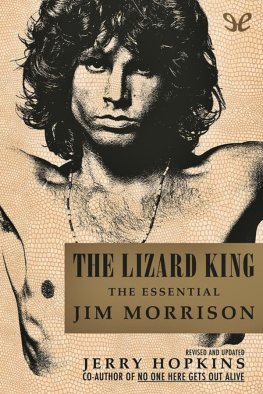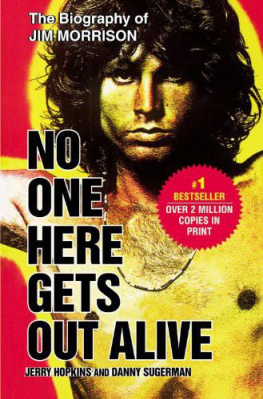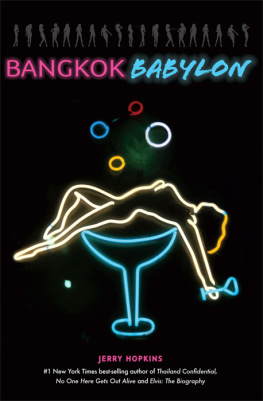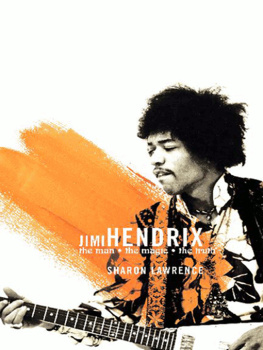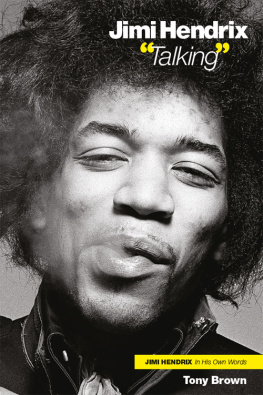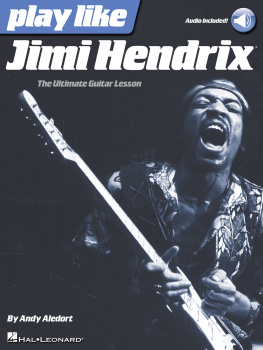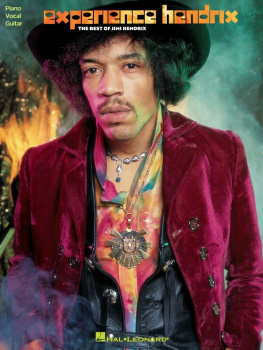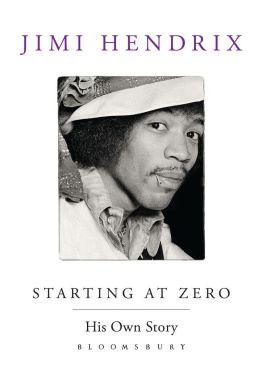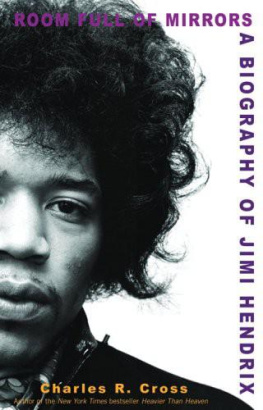
ALSO BY JERRY HOPKINS
THE ROCK STORY
GROUPIES AND OTHER GIRLS
(WITH JOHN BURKS)
FESTIVAL!
ELVIS: A BIOGRAPHY
THE LAST SEX MANUAL
(WITH RON PION, M.D.)
NO ONE HERE GETS OUT ALIVE
(WITH DANNY SUGERMAN)
ELVIS: THE FINAL YEARS
THE HULA
BOWIE
YOKO ONO
THE LIZARD KING:
THE ESSENTIAL JIM MORRISON


ARCADE PUBLISHING
Copyright 1983 by Jerry Hopkins, 1996, 2014 by Haku Olelo
All Rights Reserved. No part of this book may be reproduced in any manner without the express written consent of the publisher, except in the case of brief excerpts in critical reviews or articles. All inquiries should be addressed to Arcade Publishing, 307 West 36th street, 11th Floor, New York, NY 10018.
The author gratefully acknowledges permission from the following sources to reprint material:
Bella Godiva Music, Inc., for permission to quote lyrics from Angel, My Friend, Crosstown Traffic, Electric Ladyland, Voodoo Chile, Rainy Day, Dream Away, 1983, Room Full of Mirrors, Machine Gun, Dolly Dagger, and Killing Floor. No part of the above songs may be used commercially without the expressed written permission of bella Godiva Music, Inc.
CBS Songs, for permission to quote lyrics from Wild Thing by Chip Taylor, published by Blackwood Music, inc.
Chappell Music Company, for permission to quote from the following songs by Jimi Hendrix: Foxy Lady and Purple Haze 1967, 1968 by Yameta co., Ltd.; Fire and Are You Experienced? 1967 by Yameta co., Ltd.; Little Wing 1968 by Yameta co., Ltd.; If 6 Was 9 1968 by Yameta co., Ltd.; and Bold as Love 1964, 1968 by Yameta Co., Ltd. All rights controlled by Unichappell Music, Inc. International copyright secured. All rights reserved. Used by permission.
Devon Music, Inc., for permission to use lyrics from My Generation, words and music by Peter Townshend, 1965 by Fabulous Music, ltd., London, England. TRO-Devon Music, Inc., New York, controls all publication rights for the U.S.A. and Canada. Used by permission. GPI Publications, for permission to reprint material from the Guitar Player magazine Hendrix Special by Don Menn, published by GPI Publications.
The Estate of Jimi Hendrix and James A. Hendrix, his father, for permission to reprint a poem by Jimi Hendrix. No part of said poem may be used commercially except by the express written consent of James A. Hendrix.
Warner Bros., Inc., for excerpts from The Jimi Hendrix Story 1973, Warner Bros., Inc. All rights reserved.
Arcade Publishing books may be purchased in bulk at special discounts for sales promotion, corporate gifts, fund-raising, or educational purposes. Special editions can also be created to specifications. For details, contact the special Sales Department, Arcade Publishing, 307 West 36th Street, 11th Floor, New York, NY 10018 or arcade@skyhorsepublishing.com.
Arcade Publishing is a registered trademark of Skyhorse Publishing, Inc., a Delaware corporation.
Visit our website at www.arcadepub.com.
10 9 8 7 6 5 4 3 2 1
eISBN: 978-1-62873-863-6
Library of Congress Cataloging-in-Publication Data is available on file.
ISBN: 978-1-61145-870-1
Printed in the United States of America
Table of Contents
I NTRODUCTION
It was a story made for the movies. Not the story of Jimi Hendrixs life but that of his death, and what happened nearly a quarter of a century after it. It could only be a true story. If someone wrote it as fiction, as a novel or a screenplay, no one would believe it.
Even during Jimi Hendixs lifetime, there is evidence to show that the guitarist was abused by his professional representatives. Theres nothing new about that; its an entertainment business clich. So, too, during the time following his death the rip-offs continued, until finally Jimis father, his sole heir, employed a black lawyer in Los Angeles to sort out and handle his increasingly complex affairs. All went well, or seemed to, until 1993, when Al Hendrix, a seventy-two-year-old retired gardener, went to court claiming that the California attorney had taken his sons musical legacy and sold it to the highest bidder. Leo Branton Jr., the Los Angeles lawyer who had represented the Hendrix estate for more than twenty years, was accused of getting the elder Hendrix to sign away his sons musical copyrights to several offshore companiesneglecting to say that he, the lawyer, had an interest in those firms. For the Jimi Hendrix catalog of songs and recordings, released and unreleased, Al Hendrix reportedly was paid $500,000, plus a modest annual annuity. The offshore companies then negotiated a sale to one of the largest American musical conglomerates, for as much as $75 million.
Thenand this is where the story gets gooda longtime Jimi Hendrix fan came to the rescue, providing Al Hendrix with the money to fight back. That man was Paul Allen, a lifelong Seattle resident and cofounder with Bill Gates of Microsoft, owner of the Portland Trail Blazers basketball team and ranked in 1995 by Forbes magazine as the fourth richest man in the United States.
What happened nexta courtroom story equal to anything novelist John Grisham might concoctis described in the epilogue to this book.
When Rolling Stone magazine published a brief history of the electric guitar, the tall, thin performer who played the guitar upside down (to accommodate his left-handedness) was placed in a class by himself, a mammoth talent whose pioneering use of effects like phasing, wah-wah and fuzz tone have become part of the rock guitarists vocabulary.
Other publications in the field agreed. Said Guitar Player in 1975, GP has never before devoted an entire issue to the life of a particular guitarist, but now is a good time to start. Jimis contribution to our instrument is so wide-ranging, so massive, that fully five years after his death our offices continue to receive almost daily requests [for information] about his music, his technique, his equipment. Clearly no other electric guitar player has had the influence of this man.
Another twenty years has passed, and his stature has grown exponentially. Quite simply, Jimi Hendrix was one of the most significant musical contributors not just to our time but to all time. In only a few years he defined the spectrum of the electric guitaror, rather, redefined itand influenced thousands of guitarists, many of whom went on to become worldwide stars. There are things he did on the guitar that no one yet can explain or duplicate, not even given the sophisticated electronic assistance thats been developed since his death.
Cynics call the death of a rock star at the peak of his career a good career move. Even Jimi himself, two years before he died, said, Its funny the way most people love the dead. Once youre dead, youre made for life. Sadly, there is some truth to this. In the years since Jimis death due to an apparent barbiturate and alcohol overdose at age twenty-seven, his music and life story have been one of the most consistently revered and heavily trafficked natural resources in contemporary cultural history.
During his four-year recording career, only seven albums were released, including two weak recordings thrown into the marketplace from his formative years to capitalize on his later success and a compilation of previous hitsin other words, only four that he really cared about. By 1996, another dozen were put in the shops officially, and an incredible 132 albums and singles and 238 CDs appeared on the illegal, or bootleg, market, a figure that rises weekly.
Next page

